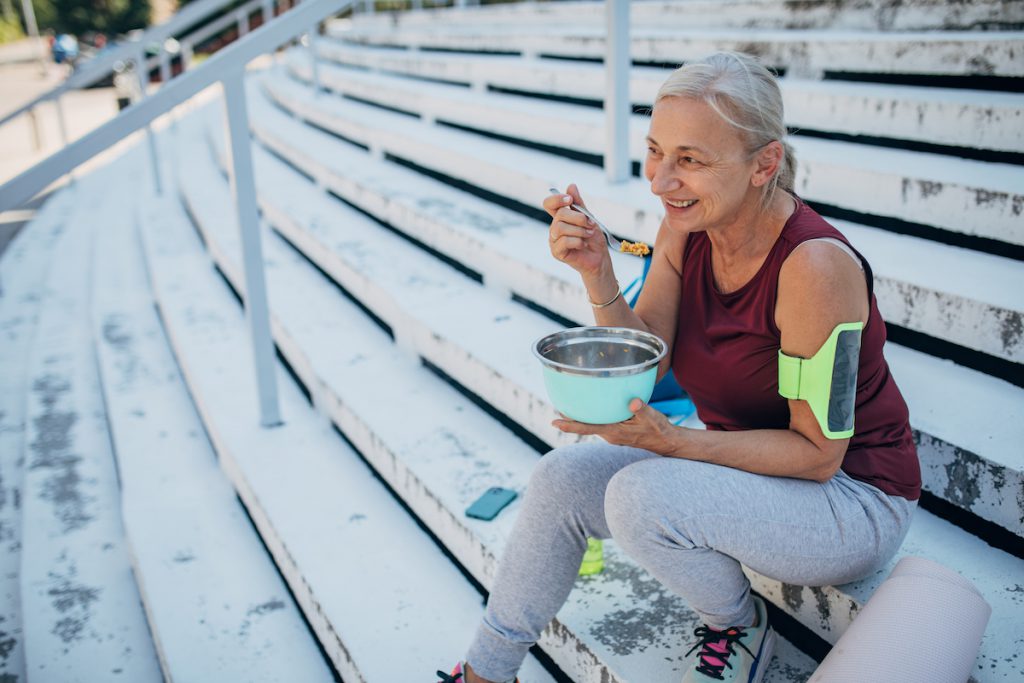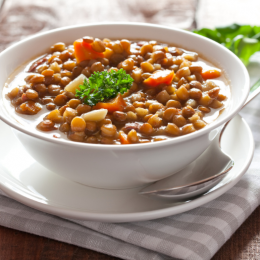10 Dos and Don’ts to Lose Belly Fat After 65
Your body changes as you age. So should your weight-loss strategy. Here’s what you need to know to shed belly fat.

The odds are good that you’ve noticed: The fat-loss tricks that reliably worked for years are less effective than they used to be.
It’s not just you with extra padding in your middle. According to Tufts Medical Center, aging slows down our basal metabolic rate, which is the biological system where our bodies burn calories at rest to keep our organs functioning. This leads to weight gain, even if we aren’t eating or exercising any differently than we did before.
And while we may be well past the point where we care about washboard abs, extra weight in the midsection does come with some significant health risks. The most dangerous kind of belly fat (called visceral fat, which surrounds organs in your abdominal cavity) has been linked to an increased risk for heart disease, type 2 diabetes, and breast cancer, according to Harvard University.
Fortunately, you can lose belly fat with certain lifestyle changes. Here’s what you can do—and what you should not—to slim down your middle and improve your health. No extreme diets or marathon running required.
Get and stay fit with SilverSneakers! Classes and events are happening right now at participating gyms, online through SilverSneakers LIVE, and at community centers near you. Activate your free online account to get started.
Do: Combine Weight Training With Cardio
This pair is a fat-burning winner. Strength training helps you build the muscle you need to rev up your metabolism, since muscle tissue burns more calories at rest than fat. Cardiovascular exercise, also known as aerobic activity, helps burn off excess calories.
According to a 2022 analysis of 114 studies published in Obesity Reviews, this combo led to more fat loss than either form of exercise alone. Aim for 150 weekly minutes of moderate intensity cardio (like brisk walking) coupled with two-weekly strength training workouts, says Logan Strollis, M.S., an exercise physiologist at LVHN Fitness in Allentown, Pennsylvania.
If 150 weekly minutes feels like a big ask, go with what your body can handle. Any activity is better than none, after all. It’s also important to choose activities that you enjoy, because you’ll be more likely to do them, says Janet J. Boseovski, Ph.D., a professor of psychology at the University of North Carolina at Greensboro.
Try a SilverSneakers LIVE Cardio & Strength (Express) class. This 15-minute class explores short cardio and strength segments to build overall endurance. Weights and tubing are recommended but not required. View the schedule and RSVP here.
Do: More Reps With Lighter Weights
All forms of strength training can help you build lean muscle mass to support your metabolism. But high-rep sessions—ones where you complete 12 to 20 repetitions per set—offer an added bonus, says Strollis. When compared to fewer reps with heavier weights, high-rep sessions can help you get your heart rate up, he says, helping you to burn more calories.
Do: Boost Your Protein Intake
Oftentimes when you lose weight, the pounds lost come from muscle instead of fat tissue. Consuming enough protein every day helps make sure your weight loss mostly comes from belly fat—and not from muscle mass, according to an analysis of 24 studies published in Nutrition Reviews.
Protein also helps dampen our hunger, so we’re less likely to reach for extra food our bodies will wind up storing as fat. And like many things, protein’s effect on the body changes as we grow older.
“Protein intake needs go up with age, because our bodies become less efficient at synthesizing and absorbing the protein that we eat,” says Kieran McSorley, R.D., of the Brentwood Physiotherapy Clinic. Ideally, aim for at least 1.2 grams of protein per kilogram of body weight, he says.
For a 150-pound person, that means 81 daily grams of protein. To reach that number, you might consume:
- 6 ounces of Greek yogurt at breakfast (about 18 grams)
- 6 ounces of chicken at lunch (about 56 grams)
- ½ cup of pinto beans with your dinner (about 11 grams)
For ideas to help boost your protein intake, check out the SilverSneakers protein-boosting meal plan.
Do: Prioritize Nutrient-Dense Foods
As you grow older, your body may require fewer calories. But you still need to consume enough nutrients to stay healthy, says McSorley.
To get you there, he recommends a daily diet consisting of:
- Colorful fruits and vegetables
- Leafy greens
- Lean protein
- Low-fat dairy products
- Whole grains
Fueling your body properly allows you to have the energy to get the exercise that helps you burn calories and fat.
Do: Watch Your Stress Levels
When you feel overwhelmed, levels of cortisol, a stress hormone, rise, contributing to the storage of belly fat. To help combat this, make sure your daily activities bring you joy whenever possible, says Boseovski.
Remember how Marie Kondo taught people to let go of their stuff? You can do the same with your stress-inducing commitments.
Ask yourself: What do I find meaningful?
That’s the stuff you want to keep doing, says Boseovski. If a joyless task can be ditched with no financial or personal consequences, just let it go.
Try a SilverSneakers LIVE Stress Management Strategies class. In just 30 minutes, learn mindfulness practices and education tips designed to help you build resiliency and manage stress more effectively. View the schedule and RSVP here.
Do: Pay Attention to How You Feel When You Eat
If you’re like most of us, grabbing a bag of chips or cookies when you’re feeling stressed seems like a fantastic idea. But empty calories like those aren’t good for our waistline—or our energy levels.
To counteract stress eating, Boseovski suggests keeping a food journal. When you find yourself reaching for snacks—despite not truly being hungry—jot down some notes.
Ask yourself:
- What’s going on around me?
- What am I trying to avoid or escape by eating?
These notes will help you to come up with new coping strategies. For example, instead of eating, you might go for a walk, snuggle with your dog, or see if a friend wants to join you for a cup of coffee.
Do: Relax Before Bed
Quality sleep helps keep our metabolism humming. So anything you can do to help prepare you for a good night’s sleep, the better off you’ll be.
A few simple tricks that promote better rest:
- Ditch glowing screens an hour before bedtime
- Keep the temperature in your bedroom cool
- Wind down with a book before you turn
Visualization techniques can also be useful, says Sriram Machineni, M.D. He’s the director of the Fleischer Institute Medical Weight Center at the Albert Einstein College of Medicine
When his clients struggle to fall asleep, he recommends yoga nidra, a visualization strategy that can help you relax.
“It has been extremely helpful for my patients,” says Machineni. You’ll find dozens of free 20-minute yoga nidra sessions on YouTube, he says. Sample a few of them so you can choose one that feels soothing to you. Then play it in a calm room when you are ready to turn in.
Subscribe to our newsletter
It's quick and easy. You could be one of the 13 million people who are eligible.
Already a member? Click to discover our 15,000+ participating locations.
Follow Us
One part of yoga nidra involves doing a body scan. Press play to try a 4-Minute Body Scan Meditation with SilverSneakers LIVE trainer Shannon Thigpen:
Don’t: Fixate on Planks or Situps.
It may seem like working your core muscles would be a great place to start to burn belly fat. And while core exercises like planks do offer a lot of benefits—improving posture and reducing your risk of injuries, for example—they’re not the best tool for reducing belly fat, says Strollis.
“A lot of people think if they do hundreds of crunches or planks, it will address belly fat. But that doesn’t work,” he says. And scientific research bears this out.
When study participants completed two sets of 10 repetitions of seven different abdominal exercises five days a week, their amounts of belly fat were relatively unchanged six weeks later.
Regular cardiovascular exercise, paired with whole-body strength training, is a more successful fat-blasting strategy, the study authors found.
Don’t: Skip Your Warmup
Nothing sidelines your exercise sessions faster than an injury. And when older adults get injured, it’s often because they jumped right into a strength training or cardio session without a warmup, Strollis says.
Learn more and try a few simple warmup exercises by reading The Right Way to Warm Up Before Exercise here.
Don’t: Skimp on Fiber-Rich Foods
Because fiber is a carbohydrate—and carbs fuel the body—eating high-fiber foods can help give you the stamina to work out. Fiber also has other beneficial effects on the body that impact belly fat.
A study from Brigham Young University examined the eating habits of 6,374 people, and it found that fiber can help improve insulin function. That’s important, says McSorley, because insulin resistance is thought to contribute to the accumulation of belly fat. Insulin resistance is also a hallmark of type 2 diabetes.
Aim for at least 25 grams of fiber per day from fruits, vegetables, whole grains, and legumes, says McSorley.
Recommended reading:
5 Best Ways to Take Your Body Measurements
Should You Care About Your Body Mass Index?
See our sources:
- Study on strength training for weight loss: Obesity Reviews
- Effects of protein on body composition: Nutrition Reviews
- Link between stress and belly fat: Obesity
- How abdonimal exercises impact belly fat: Journal of Strength Conditioning Research
- Link between fiber intake and belly fat: Nutrients
Check Your SilverSneakers Eligibility Instantly
SilverSneakers members can go to thousands of gyms and fitness locations across the nation, plus take SilverSneakers LIVE online classes that are designed for seniors of all levels. If you have a Medicare plan, it may include SilverSneakers—at no additional cost. Check your eligibility instantly here.
Already a member? Get your SilverSneakers member ID and exclusive fitness content by activating your online account here.
Not eligible for SilverSneakers? You can still get 200+ free SilverSneakers On-Demand videos and stay in touch with us by creating your online account.





